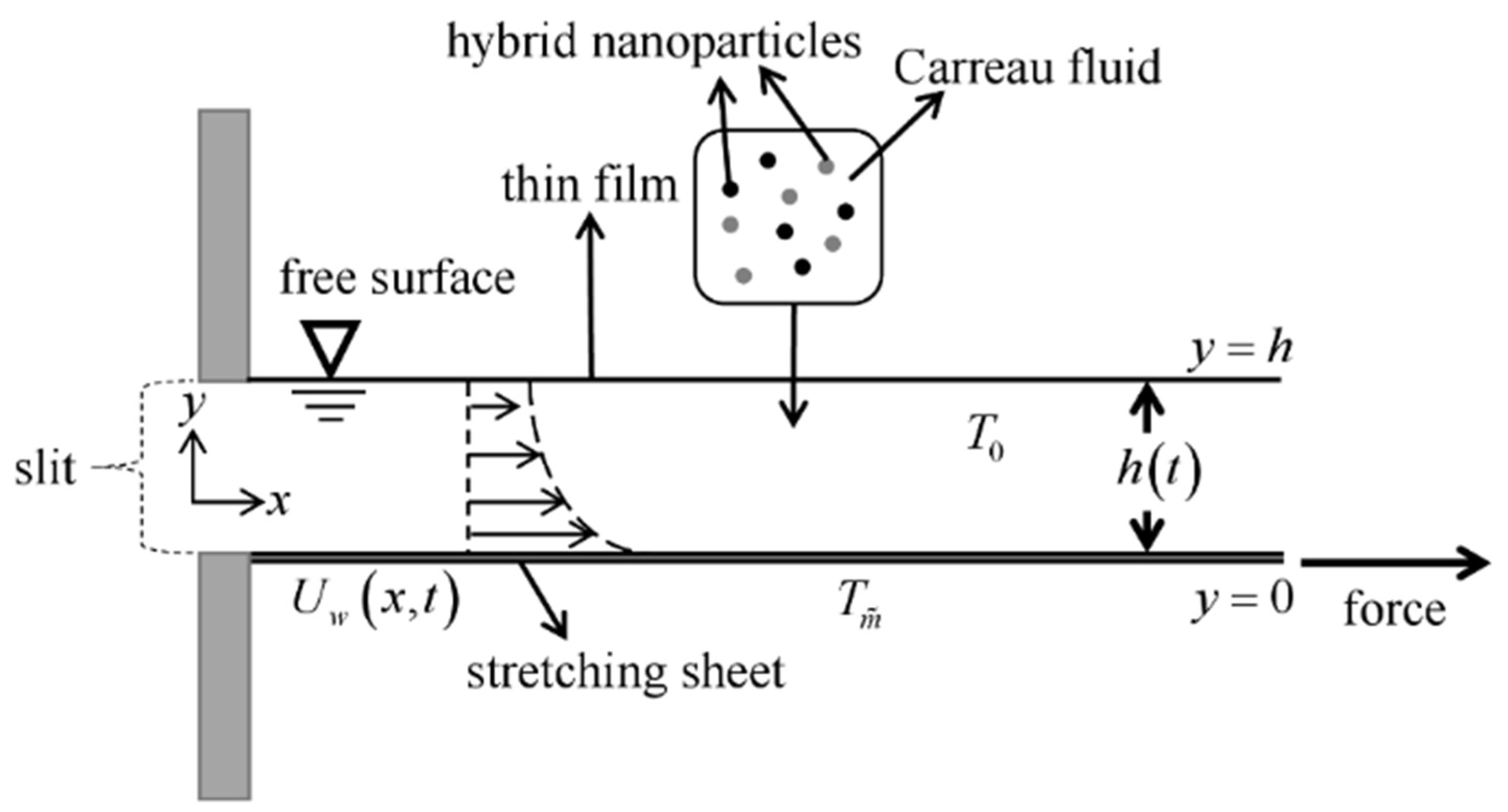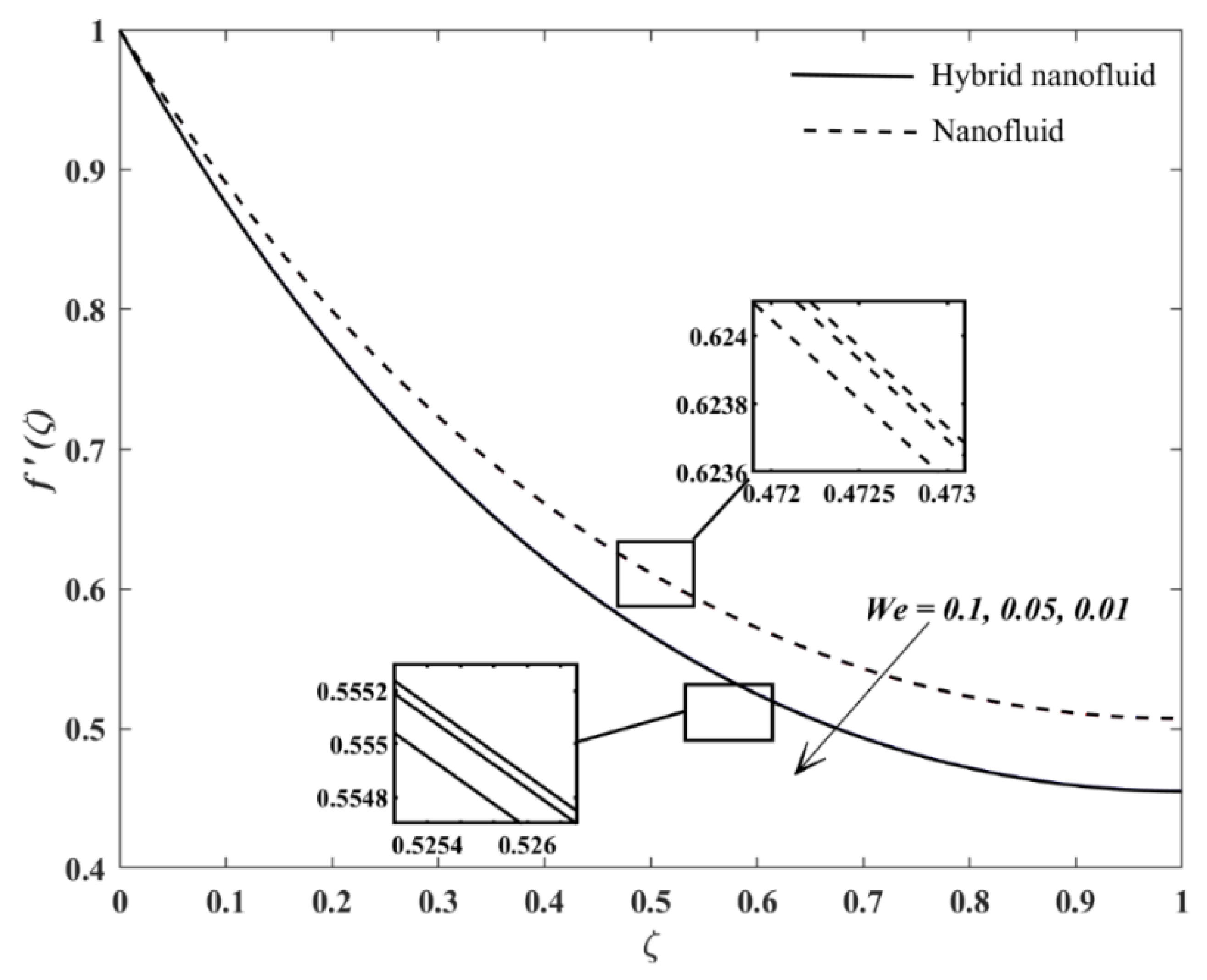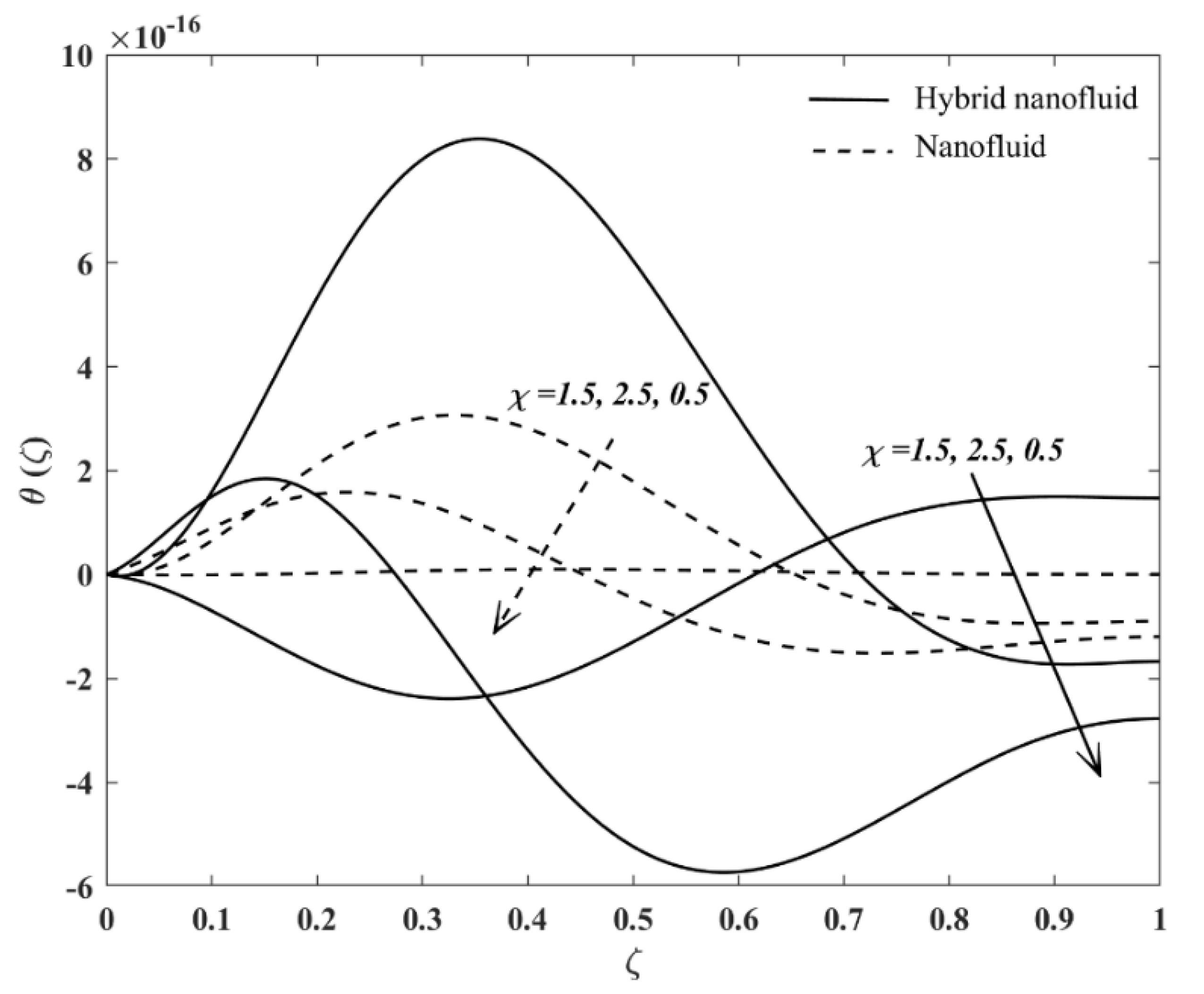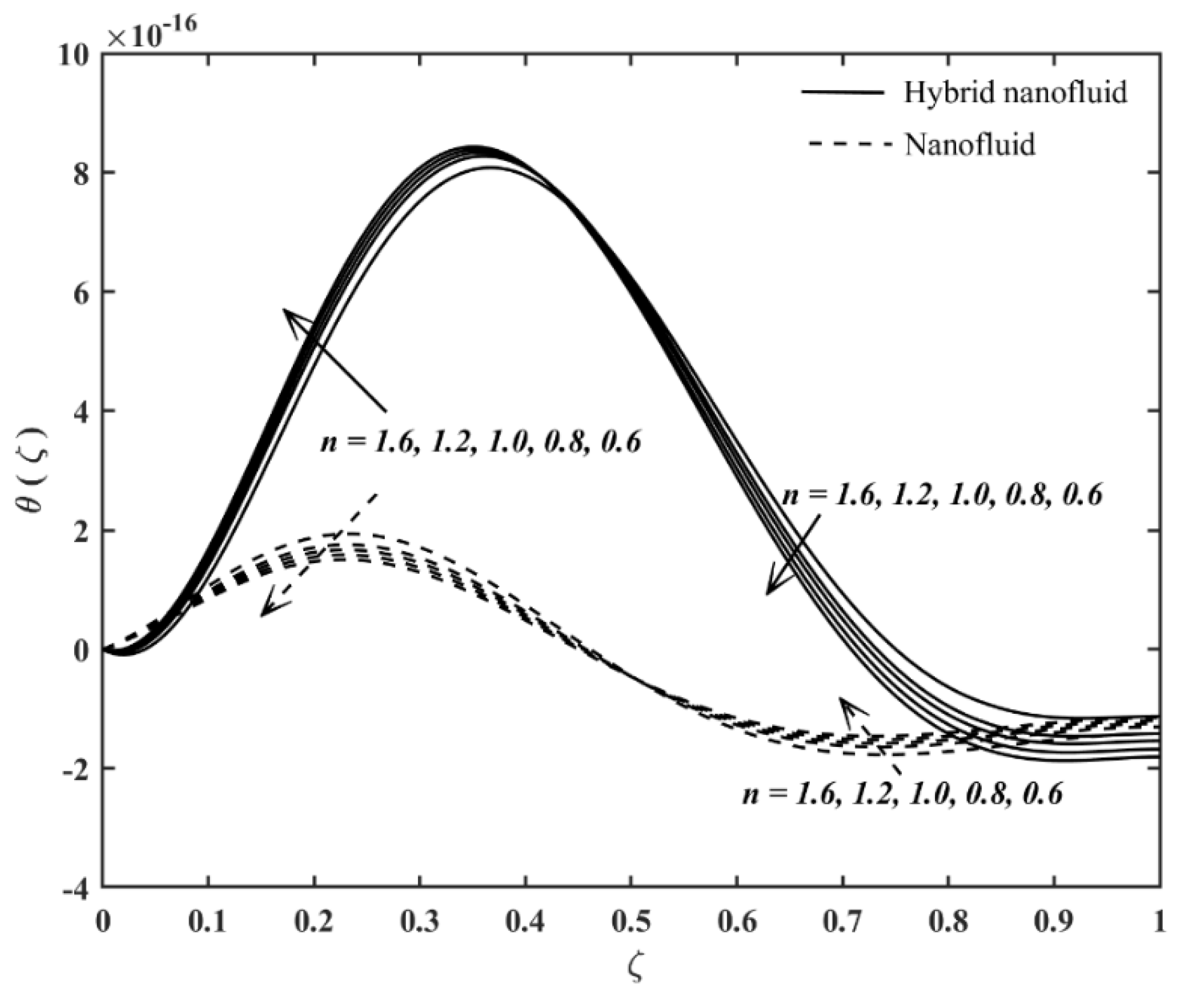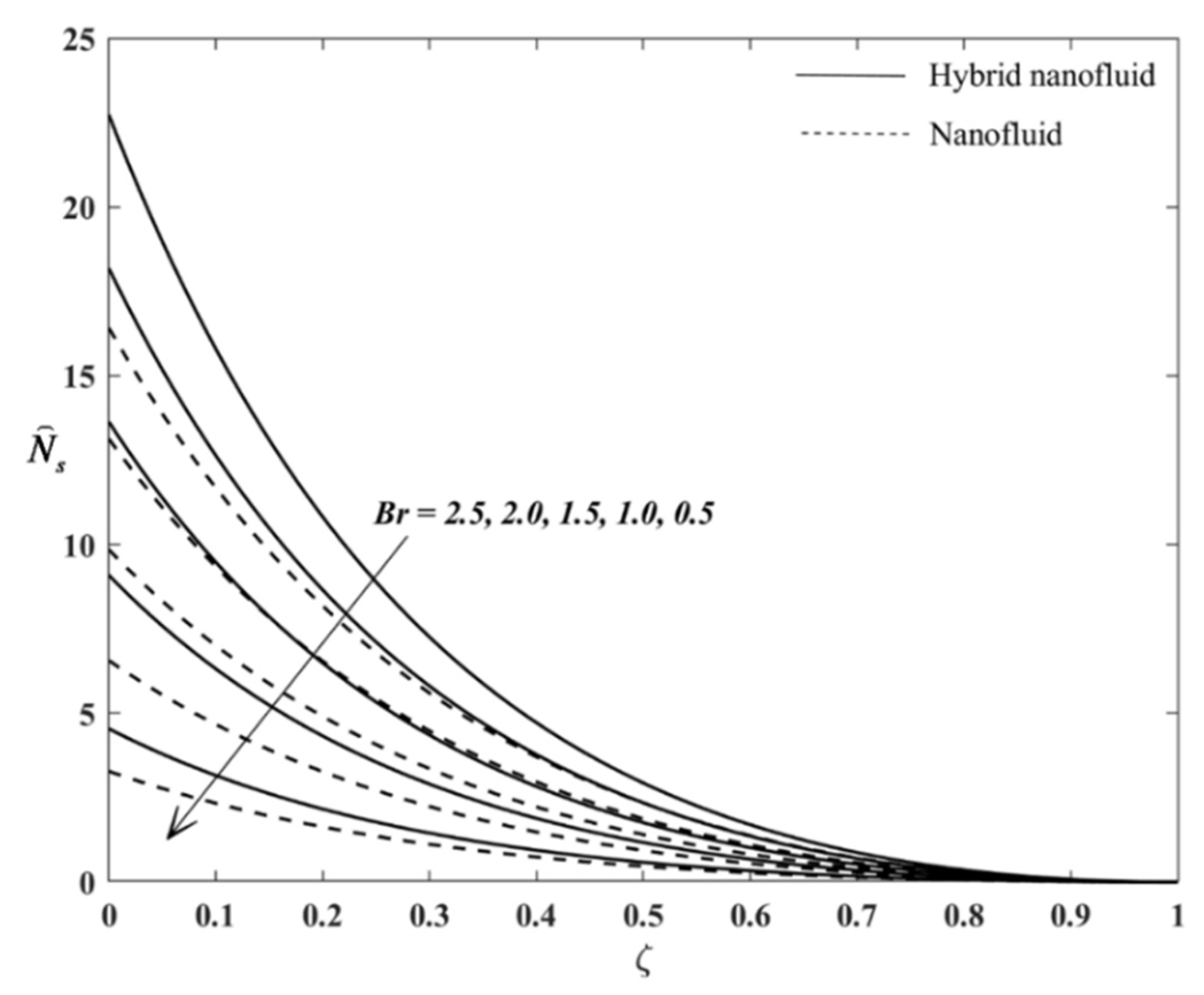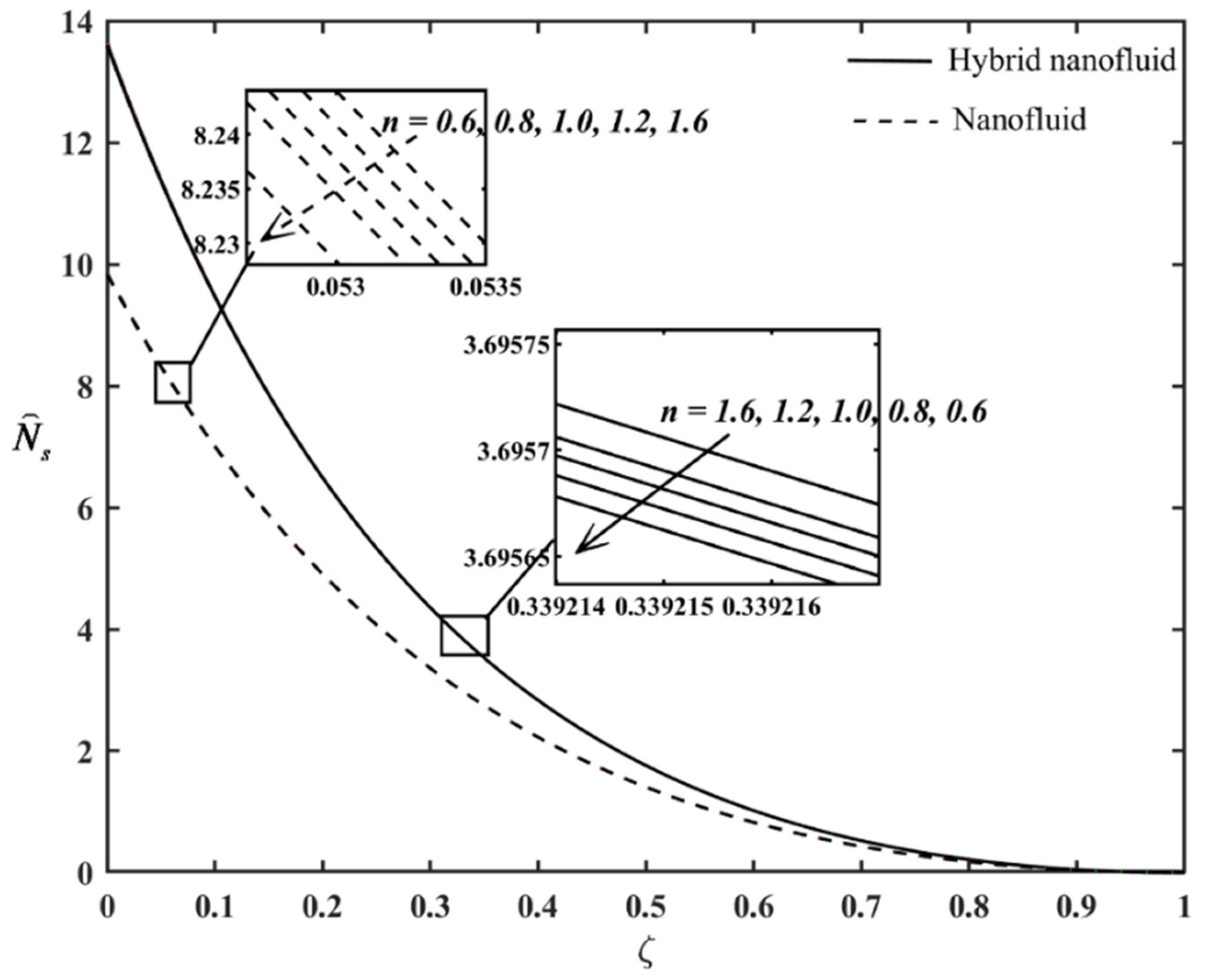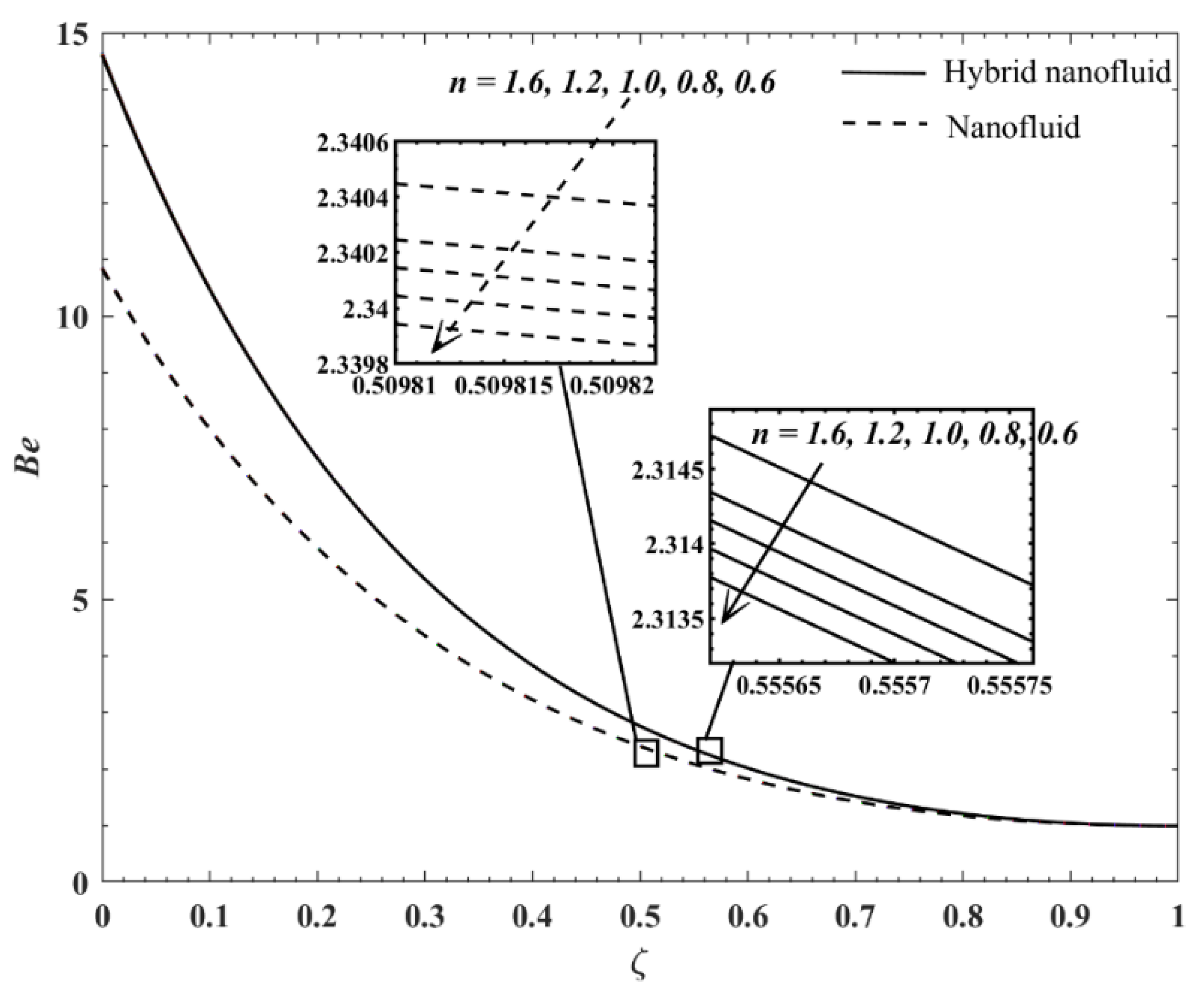1. Introduction
The thin film flow research has a great prospect in technological advancement due to its significance in producing electronic devices such as integrated circuits and microscopic fluidic devices [
1]. For example, one can see how a solid surface is coated by a thin liquid film in those manufacturing operations. Another potential manufacturing process subset to the thin film flow application is the cast film extrusion that produces polymer sheets and films [
2]. Realising the strength of the thin film flow research as an enzyme to attain the next stage of technological development, Wang [
3] pioneered the problem of the thin film flow past an accelerating sheet and attested the unavailability of similarity solutions when the flow unsteadiness’ rate exceeds 2. Then, Usha and Sridharan [
4] revisited the flow problem in [
3] asymmetrically and proved that the similarity solutions are absent when the flow unsteadiness’ rate exceeds 4. As time went by, the researchers learned that heat transfer analysis is crucial in the thin film flow problem, aligned with the initiative to comprehend the heat exchangers and chemical processing equipment’s design. Thus, Andersson et al. [
5] solved the thin film flow and heat transfer past an accelerating sheet; they also devised a novel similarity solution for the temperature field. This contribution of [
5] is remarkable and highly assists in investigating the heat transfer aspect in the present work. After that, Wang [
6] presented the analytic solutions for the thin film flow and heat transfer problem over an unsteady accelerating sheet. The strong contributions of [
3,
4,
5,
6] are the impetus for the thin film flow and heat transfer research under the following effects: thermocapilarity [
7,
8], general surface temperature [
9,
10], thermal radiation [
11], magnetohydrodynamics (MHD) [
12], viscous dissipation [
13], slip effects [
14,
15].
The strength of the non-Newtonian fluid in illuminating varying fluid viscosity under the applied force has vast industrial applications and managed to attract the researchers’ attention to be considered under various settings, such as in [
16,
17]. On the other hand, the researchers’ consideration of the non-Newtonian fluid in the thin film flow problem is raised because the protective coating applied on an extrudate is a non-Newtonian fluid. Therefore, Andersson et al. [
18] investigated the power-law thin liquid film flow past an accelerating sheet and found a contradict trend in the fluid velocity when the power-law fluid adapts to the pseudoplastic and dilatant features respectively. Furthermore, Chen [
19] enhanced the work of [
18] by incorporating the heat transfer characteristic as it is an essential factor to decide the final product’s quality. Subsequently, the researchers’ consideration of other generalised non-Newtonian fluid models such as the Carreau fluid model increased due to its validity for high and low shear rates. Myers [
20] critically analysed the generalised non-Newtonian fluid’s potential in the thin film flow and suggested that the Carreau fluid model is a better choice due to its accuracy rate. Accordingly, there is a number of significant works reported within the scope of the Carreau thin film flow; see [
21,
22,
23,
24].
Besides that, hybrid nanofluid is an incredible invention by humankind to uplift technological advancement to the next level. Choi and Eastman [
25] introduced the brilliant idea of suspending the nanosized metal element in the fluid to boost its heat transfer rate. Although nanofluid hits the peak of the researchers’ interest due to its applications in the heat transfer equipment, nanofluid is incompatible with some specified real-world applications that require substitution between some nanofluids’ properties [
26]. Thus, the hybrid nanofluid is proposed to encounter this issue through the experimental works [
27,
28], and the hybrid nanofluid managed to gain vast interest from the researchers. Shortly, the theoretical works, such as [
29] gained momentum in the hybrid nanofluid after the valuable works of Devi and Devi [
30,
31]. The hybrid nanofluid also succeeded in the thin film flow over an accelerating sheet owing to industrial applications such as microfluidics [
32]. For instance, Sadiq et al. [
33] explored the Maxwell thin hybrid nanofluid film flow across the Darcy-Forchheimer porous media and inferred that the augmentation of the heat transfer rate in the hybrid Maxwell nanofluid is better than the single-typed Maxwell nanofluid.
Melting heat transfer is a common phase experienced by industrial processes such as casting. Epstein and Cho [
34] is one of the earliest works involved in the melting heat transfer effect in the laminar boundary layer flow. Epstein and Cho [
34] solved the boundary layer flow problem past the horizontal positioned static flat surface along with the melting heat transfer effect. Ishak et al. [
35] extended the work in [
29] by considering the flow past the moving sheet and reported that the melting heat transfer effect is the decreasing function of the convective heat transfer rate. Then, Khashi’ie et al. [
36] reconsidered the problem solved in [
35] by incorporating the presence of hybrid nanoparticles and corroborated the finding as mentioned above in [
35]. Even though the melting heat transfer effect has been probed under several settings; see [
37,
38]; yet, the inspection of the melting heat transfer effect in the thin film flow is scarce. Thus, this motivates the present work to scruntise the melting heat transfer effect in the thin film flow.
Overall, the present work attempts to solve the problem of the Carreau thin hybrid nanofluid film flow past an accelerating sheet under the influence of the melting heat transfer. The present model is relatively new, and entropy generation analysis is performed. The present work also adapts the similarity transformation suggested by Andersson et al. [
5], and the formulated mathematical model has been solved in the built-in collocation method, the bvp4c, to produce the approximate solutions. Furthermore, non-uniqueness solutions have been reported for every case of governing parameters’ variations. The findings of the present work may serve as a reference for improving the material processing industry.
2. Mathematical Model
Ruminate the Carreau fluid flow bounded by a thin liquid film and a horizontally placed accelerating sheet from a narrow opening at the Cartesian coordinate system origin. The two-dimensional flow is assumed to be incompressible, unsteady while the thin liquid film has an unvarying thickness,
Figure 1 depicts the flow setup, and
coordinate is located normal to the
coordinate. The sheet’s accelerated act, which portrays the stretching sheet situation, brings about the fluid motion delimited by the thin film and the accelerating sheet. The sheet is accelerated with speed
where
and
are positive constants with dimension time
–1,
while
conveys the stretching rate. The sheet surface is impermeable and melts. The melting surface temperature is denoted by
whereas
is the fluid temperature. The wall temperature,
is defined as
and
[
39]. Here, the slit temperature and reference temperature are denoted by
and
respectively. Besides, the end effects and gravity are assumed to be very small and thus omitted. The formulated boundary layer model in the present work is only sensible if the liquid film thickness does not overlap with the boundary layer thickness. Otherwise, the present formulated model becomes irrational [
40]. Also, the planar thin liquid film is assumed to be smooth and free of any surface waves [
5].
The Carreau fluid’s Cauchy stress tensor is given as [
20]
where
Here,
is the Cauchy stress tensor,
is the pressure,
denotes the identity tensor,
signifies the zero-shear-rate viscosity,
is the infinite-shear-rate viscosity,
implies the material time constant, and
represents the power-law index. The shear rate,
can be elaborated as
In Equation (3),
is the second invariant strain rate tensor and
is the Rivlin-Ericksen tensor expressed further as
The most practical cases where
is considered. Normally, the value of
is determined by the extrapolation procedure or chosen to be zero (suggested theoretical value) [
41]. Thus, in the present work, the value of
is set to zero, and affect Equation (1) to become
The Carreau fluid model shows pseudoplastic, dilatant, and Newtonian features when
and
respectively, where
is the power-law index. Under these assumptions, the governing liquid film flow of the Carreau fluid can be written as [
42].
where
and
are the velocity components along the
- and
- directions, respectively,
is a material time constant,
signifies the power-law index. Meanwhile,
and
are the hybrid nanofluid’s heat capacity, dynamic viscosity, density and thermal conductivity, respectively. The further definition of
and
are expressed in
Table 1.
According to
Table 1, the nanoparticle volume fraction is
and
reduces the model into a regular fluid. Next,
and
signify the Au’s and Cu’s nanoparticle volume fraction, respectively. The total volume concentration of two types of nanoparticles suspended in the hybrid nanofluid is determined as
Meanwhile,
and
are the densities of the base fluid and the hybrid nanoparticle, respectively,
and
are the thermal conductivities of the base fluid and the hybrid nanoparticles, respectively,
and
are the heat capacitance of the base fluid and the hybrid nanoparticle, respectively. These correlations are based on physical assumptions and agree with the conservation of mass and energy. Thus, the physical properties of the base fluid (water), gold (Au) and copper (Cu) hybrid nanofluids are given in
Table 2.
The Equations (6)–(8) are getting along with the boundary conditions
At
the kinematic constraint is enforced in the fluid motion through
The wall shear stress and heat flux disappear entirely at the adiabatic free surface and thus
at
Next, we introduce the similarity transformations as follows (Andersson et al. [
5]):
where prime infers the derivative concerning
Employing the similarity conversion as in (10) and (11) into the governing model (6)–(9) satisfies the continuity equation, and the remaining equations are transformed as follows:
with the boundary conditions
wherein
is the local Weissenberg number [
46],
is the dimensionless measure of unsteadiness, the Prandtl number is defined as
while the melting heat transfer parameter is signified by
. Moreover,
is an unknown constant that conveying the dimensionless film thickness.
also implies the similarity variable
value at the free surface, and hence the expression in (11) can take the following form:
This unknown constant
must be calculated as an integral part of the boundary-value problem. Thus,
elucidates the film thickness’s rate of change. On the other hand, when
and
the Carreau fluid model in Equations (12) and (13) reveals the Newtonian characteristics. The physical quantities of interest in the present work are the local skin friction coefficient
and the local Nusselt number
which can be defined as follows:
Here, the wall shear stress
and the heat flux from the surface of the sheet
are given by [
47].
By employing (10)–(11) and inducing (19) into (18) provides the following expression.
The local Reynolds number is defined as
4. Results and Discussion
The transport phenomena in the thin film flow regime can be learned by plotting the velocity and temperature profiles. In addition, calculating the local skin friction coefficient, the local Nusselt number and the dimensionless film thickness when the pertinent parameters vary is also necessary to inspect the present model’s performance. Thus, all numerical outputs were generated by setting the governing parameters’ values within the following fixed range:
and
. The Prandtl number is fixed to 8 throughout the computation process. Also,
and
represents the gold (Au) and copper (Cu) nanoparticle volume fractions, respectively. The numerical outputs are compared between the Carreau hybrid nanofluid case, where
and the single-typed Carreau nanofluid is considered with
. These parameter values are chosen based on the availability of the numerical solutions. However, those parameter values lie within the acceptable range established in previously published works. Equations (12)–(14), which convey the simplified form of the present thin film flow problem, are solved using the bvp4c function found in the MATLAB 2019a software. This built-in collocation code eases the solving process even though the present work has dimensionless film thickness as the unknown parameter [
50]. Besides that, all computed numerical results are accurate within
In order to test the precision of the present method, the thin film flow problem studied by Wang [
6] have been resolved via the bvp4c function, and the comparison of the results is given in
Table 4.
Table 4 proves that the built-in collocation method agrees well with the numerical results produced via the homotopy analysis method in [
6]. Meanwhile, the CPU time for calculating the non-uniqueness solutions is presented in
Table 5. In this sample, it is apparent that the CPU time increases from the first to the second solution in every case of
n. Before the presentation and discussion of the results go further, it is appropriate to confer about the non-uniqueness numerical solutions. It is undeniable that more than one numerical solutions are obtainable by providing a good set of guess values since that is the built-in bvp4c routine’s requirement. The present work found that the second solutions always yield negative film thickness. The negative film thickness implies the thin liquid film’s distortion, and hence an ideal thin liquid film cannot be formed [
23]. Therefore, the trends showed by the second solution are disregarded.
Now,
Table 6 demonstrates the trend of
for the Carreau hybrid nanofluid and Carreau nanofluid when
increases. The increment of
from 0 to 0.3 affects the dimensionless film thickness to decrease by 0.25% for Carreau hybrid nanofluid and decrement by 0.18% for the Carreau nanofluid. The reason for this occurrence can be collected from
Figure 2 and
Table 7.
Figure 2 shows that the fluid velocity increases insignificantly across the flow regime when
increases. The increment in
elucidates a longer relaxation rate; thus, the Carreau fluid takes more time to react with the external forces. Since the accelerating sheet imposes drag force towards the Carreau fluid (this can be evident by the negative values of
in
Table 7), the fluid velocity increases slightly past the unsteady accelerating sheet, which elevates the wall shear stress and increases the values of
in a minimal amount.
Meanwhile,
Figure 3 displays the temperature profiles across the thin film flow vicinity. For the Carreau fluid associated with the hybrid nanoparticles, the temperature increases when
increases. This behavior is evident when
. It should be noted that the fluid is under the influence of shear thinning effect
, and hence the fluid viscosity may decrease with the act of the accelerating sheet and the melting heat transfer’s effect. At this moment, when the effect of
is amplified, the fluid temperature augments since the relaxation time is prolonged. A similar result has been reported by Hayat et al. [
51]. However, after
the fluid far from the accelerating surface is less affected with the melting heat transfer and thus, the fluid temperature decreases when
increases. On the other hand, in the case of the Carreau nanofluid, fluid temperature increases with declining values of
when
and the opposite trend is observed after
. Such an interesting difference in the trend might be due to the suspended nanoparticles’ thermal conductivity in the base fluid. Besides that,
Table 8 tabulates changes in the heat transfer rate at the accelerating impermeable surface. The flow with the copper nanoparticles spectacle a gradual increase in
and this is acceptable because copper has better thermal conductivity and results in an increased rate in heat exchange. However, the hybrid nanofluid does not exhibit a gradual degree of improvement. The heat transfer rate decreases when
’s value increases from 0 to 0.3. The increment in the fluid relaxation time affects the Carreau hybrid nanofluid to become warm, which lowers heat flux from the accelerating surface and diminishes
The results’ discussion is further by examining the behavior of the temperature profiles and
when
increases. Even though the temperature profiles in
Figure 4 reveal an unusual degree of dissonance,
Table 9 informs that the convective heat transfer rate at the accelerating sheet increases in the single-typed nanofluid but deteriorates in the Carreau fluid with hybrid suspensions. The increment in
indicates more cold fluid molecules exist from the melting accelerating sheet towards the warm fluid. Therefore, the nanofluid temperature declines at the moving surface and augments the heat exchange rate. The work of Khan et al. [
52] also conveyed such similar result. Conversely, the hybrid nanofluid temperature may have retained a low thermal conductivity, ensuring the low heat flux rate and reducing
at the accelerating surface.
Table 10 confirms that when the Carreau fluid with the presence of the nanoparticles changes its character from the shear thinning to the shear thickening feature, the dimensionless film thickness slightly increases, in increments of about 0.035% and 0.025% for the Carreau hybrid nanofluid and Carreau single-typed nanofluid, respectively.
Meanwhile, the temperature profiles in
Figure 5 display that when
the Carreau hybrid nanofluid temperature decreases while
increases from 0.6 to 1.6. This is because the dilatant feature retards the heat energy transmission. However, when the liquid film vicinity travel at
the fluid temperature becomes an increasing function of
The area far from the accelerating sheet is possibly less affected by the shear force from the accelerating sheet, so heat transmission is reduced. Also, from
Figure 5, it is observed that the fluid temperature is low at the area far from the accelerating sheet compared to the fluid temperature near the sheet’s surface.
Table 11 identifies that the heat transfer rate at the accelerating sheet gradually decreases for the Carreau hybrid nanofluid when
increases. This is true because Metzner et al. [
53] corroborated that dilatant fluid has a lower heat transfer rate than the shear-thinning fluid. On the other hand, the opposite trend is perceived for the single-typed hybrid nanofluid. In the single-typed nanofluid considered in the present work, the nanoparticle volume fraction is less than the hybrid nanofluid, which may increase the fluid’s thermal conductivity as the low-temperature molecules enter the flow stream. Thus, a moderate increase in
’s values can be noticed along with the increment of
Table 12 delivers the decrement of
along with the increment of
The strengthening effect of
reduces the wall shear stress at the accelerating sheet. Hence, the values of
decline.
Figure 6,
Figure 7,
Figure 8 and
Figure 9 show the results of the entropy generation analysis.
Figure 6 views the increment in
when
increases. Adding value in
engenders more heat in the fluid flow vicinity, affecting the system more in chaos and resulting in undesirable flow systems’ performance. Moreover,
Figure 7 exposes the Bejan number profiles when
varies, and the values of
increases along with the increment in
It is clear that the heat transfer irreversibility is gradually influencing throughout the flow system when
rises, except for the case of the Carreau single-typed nanofluid, and
.
Figure 7 indicates that when Carreau nanofluid at
fluid friction irreversibility dominates the flow system.
Figure 8 and
Figure 9 present the profiles of
and
profiles when
varies. The variation in
gives insignificant changes on
and
profiles. For example, from
Figure 8, the state of the Carreau fluid from portraying the shear-thinning trait and then to the shear-thickening feature yields more heat energy incorporated to the system but minimal. However, the heat transfer irreversibility highly influences the fluid flow system, although
Figure 9 shows the minor decrement in
when the values of
increases.
